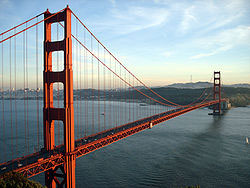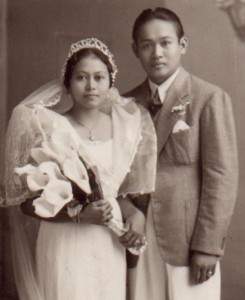A Filipino’s cameo role at the birth of the Golden Gate Bridge
 SAN FRANCISCO—The Golden Gate Bridge is one of the most beautiful spots in the world.
SAN FRANCISCO—The Golden Gate Bridge is one of the most beautiful spots in the world.
The best place to see it is from the Marin Headlands across from San Francisco. The best time is when the sky is clear. But even when there’s a patch of fog covering parts of the bridge, the view can be magical, as the Golden Gate’s towers appear to be floating in the sky.
The Golden Gate Bridge will celebrate its 75th birthday this month, an occasion that will be marked by festivities and exhibits on the history of the one of the world’s most famous landmarks.
There’s a Filipino twist in this story.
When the Golden Gate Bridge finally opened, a Filipino from San Antonio, Zambales played a small, supporting role. His own personal story was part of a bigger narrative of the Filipino journey in the United States.
Inocencio Asuelo was the first to drive a private car across the historic bridge. Well, what the official history highlights is that Inocencio’s boss, Frank Doyle, was the first person to ride a private car across the bridge. Inocencio was his driver.
Doyle was the Santa Rosa banker who spearheaded the construction of the Golden Gate Bridge which opened on May 27, 1937.
About 200,000 people took part in what was described as a fiesta. The following day Frank Doyle was given the honor of cutting the ceremonial ribbon. Then he got in a big black Dodge driven by Inocencio and made the historic crossing.
There’s a photo of Doyle and another Santa Rosa businessman standing in front of the first private car to cross the bridge. The men are standing in the front of driver’s side of the car. It’s unclear if Inocencio was in the car when the photo was taken.
But it was a special moment in Inocencio’s life. Later, he even made a model of the Golden Gate Bridge in the backyard of their home in Santa Rosa.
“He was proud of it,” Polly Asuelo Yoro, Inocencio’s daughter, said. (She is married to my cousin Roger Yoro.) “Whenever I meet somebody and tell them about that part, they say, ‘Wow, you’ve got some history in Santa Rosa. It just makes me feel good.’”
Inocencio arrived in California in the 1930s, part of a wave of migrant Filipinos who worked as field hands or cannery workers or did odd jobs throughout the state. Inocencio found work as a member of Doyle’s household staff. In a way, he was fortunate, Polly recalled. He had a good boss in Doyle who let him and his family live in the basement of his house.
Other Filipino immigrants were not so fortunate. They were bullied in the workplace. They were driven out of hotels with signs that said, ‘Positively No Filipinos Allowed.’ They were forbidden to marry or even mingle with Caucasian women. They were underpaid and overworked, and faced constant harassment from white workers who accused them of stealing their jobs.
Their experiences are being remembered in the Filipino Voices: Past and Present Exhibition at the National Steinbeck Center in Salinas. The center was named after novelist John Steinbeck who was known for writing about the struggles of working class people during the Great Depression, especially in the classic “Grapes of Wrath.”
Steinbeck also wrote about the Filipinos. The San Francisco Chronicle quoted one of his articles:
“They are unique in California agriculture,” Steinbeck wrote in a series of articles for the San Francisco News in 1936. “Being young, male and single, they form themselves into natural groups of five, six eight … they combine their resources in the purchase of equipment, such as autos. Their group life constitutes a lesson in economy.
“… They were good workers, but like the earlier immigrants they committed the unforgivable in trying to organize for their own protection. Their organization brought on the usual terrorism.”
Inocencio was also fortunate in another way. Unlike the other Filipinos, he managed to save enough money to return to the Philippines and bring his childhood sweetheart to the U.S. Felisa Agringo was the first Filipino to live in Santa Rosa. There is now a street called Asuelo Way in the city north of San Francisco.
Polly said that even though her dad never talked about having a hard time and she herself never felt the discrimination, she eventually became aware of the struggles of other Filipinos.
 She grew up with other kids whose Filipino dads married either Mexicans or Native Americans. Some of their stories were retold in a 2008 documentary called “Remembering Our Manongs,” produced by some of the children of the Filipino old-timers in Sonoma County.
She grew up with other kids whose Filipino dads married either Mexicans or Native Americans. Some of their stories were retold in a 2008 documentary called “Remembering Our Manongs,” produced by some of the children of the Filipino old-timers in Sonoma County.
The documentary features some moving stories.
There’s one of Nick Tipon, told by his son Ken, who came to America knowing only that his friend Terry Tolentino of Oakland could find him a job when he got here.
“So he packed up and set sail for Oakland and found him in a local restaurant,” Ken Tipon recalls. “Terry said, ‘Take my job.’ I thought it was pretty amazing.”
Another story underscores the pain and isolation that many of the first Filipino migrant workers endured. John Mejia found himself lost after his uncle failed to meet him when he arrived in the U.S. A man recruited him to work in Montana.
He was put in a railcar and brought to Montana. He was only given one meal on his first day. He was so hungry he ate it quickly. Overwhelmed by his first day in America, he broke into tears.
“He just cried,” his son John Jr. recalls in the documentary. “That’s how he came to America.”
Remembering such stories and honoring those early pioneers of the Filipino community in the U.S.
Polly knew some of the filmmakers who made “Remembering Our Manongs.” “Those girls who did it – their fathers were Filipinos and their mothers were Mexican or American Indian — I’m really proud of them,” she said.
The importance of making more people aware of the Filipino journey in America is also an important goal of the Filipino Voices exhibit which historian Alex Fabros helped curate.
One panel is about Fabros’s father, who was a civil right activist and journalist, who said before his death in 1999:
“We had our families, our children. We fought for them. Give them the citizenship. Now the newcomers always ask what we did. They don’t know. They don’t care. It’s too easy for them now. They are lucky. Sometimes they have problems. But they have their civil rights, not like when we first came here. We gave them the gift, the right to be a Filipino in America.”
(The Filipino Voices exhibition will run through July 22. For more information, visit the National Steinbeck Center site.)
On Twitter @KuwentoPimentel. On Facebook at www.facebook.com/benjamin.pimentel














